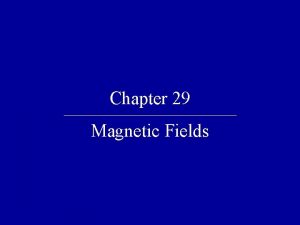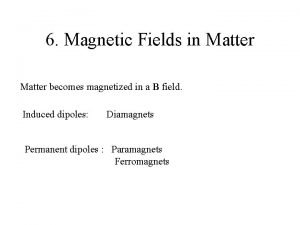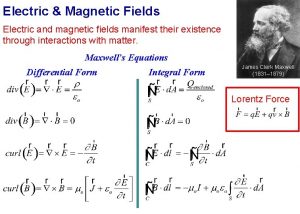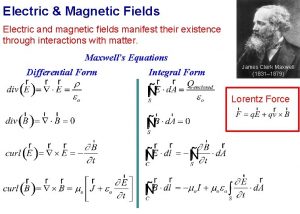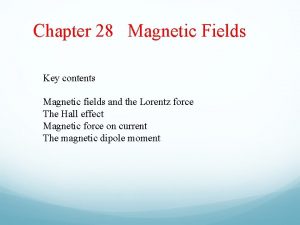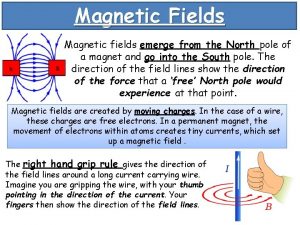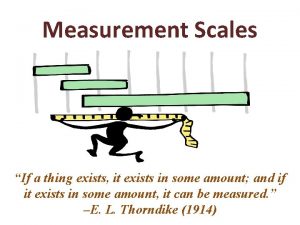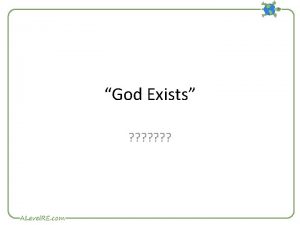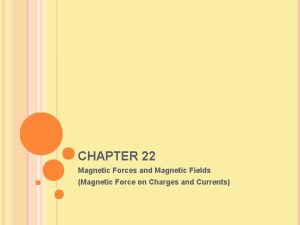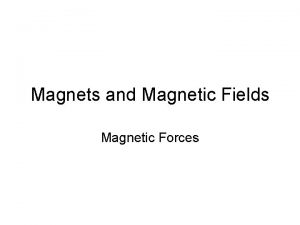Magnetic Fields Magnetic Field A magnetic field exists












- Slides: 12

Magnetic Fields

Magnetic Field A magnetic field exists; • In the region of space surrounding any moving electric charge. • Surrounds any magnetic substance. Historically, the symbol B has been used to represent a magnetic field. We can define a magnetic field B at some point in space in terms of the magnetic force FB that the field exerts on a test object, for which we use a charged particle moving with a velocity v. Note that the magnetic field lines outside the magnet point away from north poles and toward south poles. 2

Experiments on various charged particles moving in a magnetic field give the following results: • 3

• 4 The right-hand rule for determining the direction of the magnetic force

• Gauss QUIZ: What is the maximum work that a constant magnetic field B can perform on a charge q moving through the field with velocity v? 5

6

Motion of a Charged Particle in a Uniform Magnetic Field q FB never has a component parallel to v and can’t change the particle’s kinetic energy. The force can change only the direction of v. q Charged particle moves in a circle in a plane perpendicular to the magnetic field. q Start with q Then, we have q The radius of the circular path: q The angular speed: q The period of the motion: o T and ω do not depend on v of the particle. Fast particles move in large circles and slow ones in small circles, but all particles with the same chargeto-mass ratio take the same time T to complete one round trip. o The direction of rotation for a positive particle is always counterclockwise, and the direction for a negative particle is always clockwise. 7

q Circle Paths: v is perpendicular to B (uniform); q Helical Paths: v has a component parallel to B. Motion in a nonuniform magnetic field: strong at the ends and weak in the middle; n Magnetic bottle n Aurora 8 Magnetic bottle Aurora

9

Circulating Charged Particle The figures shows the circular paths of two particles that travel at the same speed in a uniform magnetic field B, which is directed into the page. One particle is proton; the other is an electron (which is less massive). Which figure is physically reasonable? 10 Arrow Into the page Out of the page

11

12
 Red fields
Red fields Force on charged particle
Force on charged particle Magnetic moment and magnetic field relation
Magnetic moment and magnetic field relation Find flux
Find flux Difference between electric field and magnetic field
Difference between electric field and magnetic field Electric field and magnetic field difference
Electric field and magnetic field difference Distinguish between magnetic and nonmagnetic materials
Distinguish between magnetic and nonmagnetic materials Magnetic force quiz
Magnetic force quiz Learning: module 26: magnetic forces and fields
Learning: module 26: magnetic forces and fields Electric currents and magnetic fields
Electric currents and magnetic fields Lesson outline lesson 1 magnets and magnetic fields
Lesson outline lesson 1 magnets and magnetic fields Electric currents and magnetic fields
Electric currents and magnetic fields Magnetic fields in matter
Magnetic fields in matter







